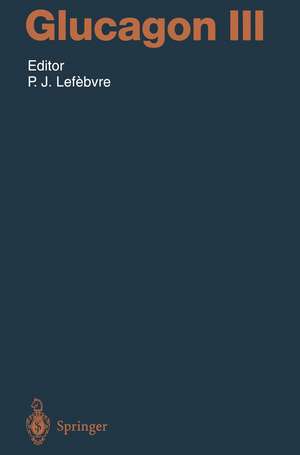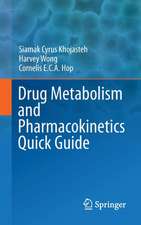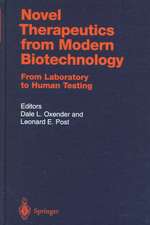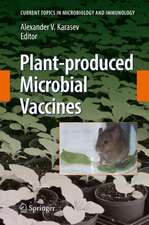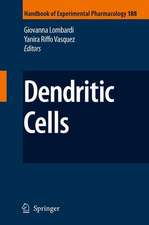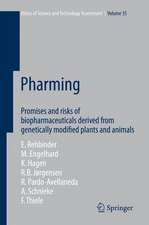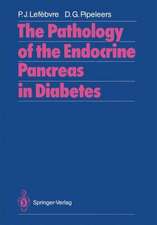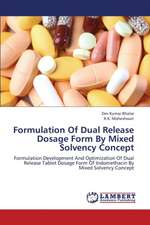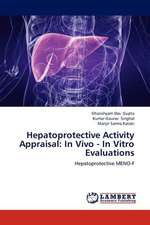Glucagon III: Handbook of Experimental Pharmacology, cartea 123
Editat de Pierre J. Lefebvreen Limba Engleză Paperback – 26 sep 2011
Din seria Handbook of Experimental Pharmacology
- 5%
 Preț: 3517.78 lei
Preț: 3517.78 lei - 5%
 Preț: 1425.97 lei
Preț: 1425.97 lei - 5%
 Preț: 1435.28 lei
Preț: 1435.28 lei - 5%
 Preț: 1430.52 lei
Preț: 1430.52 lei - 5%
 Preț: 1930.69 lei
Preț: 1930.69 lei - 5%
 Preț: 1922.47 lei
Preț: 1922.47 lei - 5%
 Preț: 1937.46 lei
Preț: 1937.46 lei - 5%
 Preț: 2117.58 lei
Preț: 2117.58 lei - 5%
 Preț: 2119.96 lei
Preț: 2119.96 lei - 5%
 Preț: 2117.38 lei
Preț: 2117.38 lei - 5%
 Preț: 1088.15 lei
Preț: 1088.15 lei - 5%
 Preț: 1098.27 lei
Preț: 1098.27 lei - 5%
 Preț: 1420.29 lei
Preț: 1420.29 lei - 5%
 Preț: 1104.84 lei
Preț: 1104.84 lei - 5%
 Preț: 1104.84 lei
Preț: 1104.84 lei - 5%
 Preț: 1108.14 lei
Preț: 1108.14 lei - 5%
 Preț: 1106.69 lei
Preț: 1106.69 lei - 5%
 Preț: 1105.77 lei
Preț: 1105.77 lei - 5%
 Preț: 1174.35 lei
Preț: 1174.35 lei - 5%
 Preț: 408.48 lei
Preț: 408.48 lei - 5%
 Preț: 409.63 lei
Preț: 409.63 lei - 5%
 Preț: 539.89 lei
Preț: 539.89 lei - 5%
 Preț: 720.47 lei
Preț: 720.47 lei - 5%
 Preț: 733.09 lei
Preț: 733.09 lei - 5%
 Preț: 731.27 lei
Preț: 731.27 lei - 5%
 Preț: 746.43 lei
Preț: 746.43 lei - 5%
 Preț: 747.72 lei
Preț: 747.72 lei - 5%
 Preț: 725.24 lei
Preț: 725.24 lei - 5%
 Preț: 742.80 lei
Preț: 742.80 lei - 5%
 Preț: 393.23 lei
Preț: 393.23 lei - 5%
 Preț: 735.66 lei
Preț: 735.66 lei - 5%
 Preț: 728.33 lei
Preț: 728.33 lei - 5%
 Preț: 389.52 lei
Preț: 389.52 lei - 5%
 Preț: 730.71 lei
Preț: 730.71 lei - 5%
 Preț: 740.58 lei
Preț: 740.58 lei - 5%
 Preț: 730.19 lei
Preț: 730.19 lei - 5%
 Preț: 723.42 lei
Preț: 723.42 lei - 5%
 Preț: 731.27 lei
Preț: 731.27 lei - 5%
 Preț: 726.68 lei
Preț: 726.68 lei - 5%
 Preț: 3516.49 lei
Preț: 3516.49 lei - 5%
 Preț: 729.26 lei
Preț: 729.26 lei - 5%
 Preț: 737.11 lei
Preț: 737.11 lei - 5%
 Preț: 730.92 lei
Preț: 730.92 lei - 5%
 Preț: 738.78 lei
Preț: 738.78 lei - 5%
 Preț: 909.94 lei
Preț: 909.94 lei - 5%
 Preț: 734.74 lei
Preț: 734.74 lei - 5%
 Preț: 727.80 lei
Preț: 727.80 lei - 5%
 Preț: 3513.38 lei
Preț: 3513.38 lei
Preț: 720.10 lei
Preț vechi: 758.01 lei
-5% Nou
Puncte Express: 1080
Preț estimativ în valută:
137.80€ • 143.06$ • 114.91£
137.80€ • 143.06$ • 114.91£
Carte tipărită la comandă
Livrare economică 25 martie-08 aprilie
Preluare comenzi: 021 569.72.76
Specificații
ISBN-13: 9783642647185
ISBN-10: 3642647189
Pagini: 376
Ilustrații: XX, 349 p. 1 illus. in color.
Dimensiuni: 155 x 235 x 20 mm
Greutate: 0.53 kg
Ediția:Softcover reprint of the original 1st ed. 1996
Editura: Springer Berlin, Heidelberg
Colecția Springer
Seria Handbook of Experimental Pharmacology
Locul publicării:Berlin, Heidelberg, Germany
ISBN-10: 3642647189
Pagini: 376
Ilustrații: XX, 349 p. 1 illus. in color.
Dimensiuni: 155 x 235 x 20 mm
Greutate: 0.53 kg
Ediția:Softcover reprint of the original 1st ed. 1996
Editura: Springer Berlin, Heidelberg
Colecția Springer
Seria Handbook of Experimental Pharmacology
Locul publicării:Berlin, Heidelberg, Germany
Public țintă
Professional/practitionerCuprins
1 The Industrial Production of Glucagon.- A. Introduction.- B. Production.- C. Analysis of Recombinant Human Glucagon.- D. Stability.- References.- 2 The Glucagon Gene and Its Expression.- A. Introduction.- B. Structure.- C. Expression.- D. Conclusions.- References.- 3 Preproglucagon and Its Processing.- A. Introduction.- B. Tissue-Specific Post-translational Processing of Proglucagon.- C. Role of Prohormone Convertases in Proglucagon Processing.- D. Secondary, Postsecretory Processing of Proglucagon-Derived Peptides.- E. Conclusions.- References.- 4 The Glucagon Receptor Gene: Organization and Tissue Distribution.- A. Introduction.- B. Cloning of the Glucagon Receptor.- C. Organization of the Glucagon Receptor Gene.- D. Tissue Distribution of the Glucagon Receptors.- E. Tissue Distribution of Glucagon Receptor Transcripts.- F. Regulation of Glucagon Receptor Gene Expression.- G. Structure/Function Analysis of the Glucagon Receptor.- H. Human Glucagon Receptor.- I. Conclusions.- References.- 5 Mode of Action of Glucagon Revisited.- A. Introduction.- B. Glucagon Actions Mediated Through Glucagon Receptors.- C. Glucagon is Processed by Its Target Cells.- D. Action of Mini-glucagon [Glucagon (19–29)] in Liver.- E. Mini-glucagon Action in Heart.- F. Glucagon and Mini-glucagon Act in Concert.- G. Conclusion and Perspectives.- References.- 6 Pulsatility of Glucagon.- A. Introduction.- B. Oscillations in Glucagon Plasma Levels.- C. Pulsatile Glucagon Secretion In Vitro.- D. Pulsatile Glucagon Delivery In Vitro.- E. Pulsatile Glucagon Delivery In Vivo.- F. Conclusions.- References.- 7 Glucagon and Diabetes.- A. Introduction.- B. Diabetogenic Effects of Glucagon.- C. The A Cell in Diabetes.- D. Circulating Glucagon Levels in Diabetes.- E. Glucagon Dysfunction in Diabetes.- F.Role of Glucagon Excess in the Metabolic Abnormalities of Diabetes.- G. Therapeutic Implications.- H. Conclusions.- References.- 8 The Search for Glucagon Antagonists.- A. Glucagon as a Drug Target.- B. Search for a Glucagon Antagonist.- References.- 9 Glucagon and Glucose Counterregulation.- A. Introduction.- B. Glycemic Action of Glucagon.- C. Glucagon Secretion.- D. Role of Glucagon in Glucose Counterregulation.- E. Conclusions.- References.- 10 Modes of Glucagon Administration.- A. Introduction.- B. Classic Routes of Administration.- C. New Routes of Glucagon Administration.- D. Conclusions.- References.- 11 The Place of Glucagon in Emergency Medicine.- A. Hypoglycemia.- B. Cardiovascular Insufficiency.- C. Vascular Effects.- D. Renal/Urologic Effects.- E. Shock.- F. Respiratory Effects.- G. Gastrointestinal Effects.- H. Radiographic Studies.- I. Adverse Effects.- References.- 12 The Place of Glucagon in Medical Imaging.- A. Introduction.- B. Upper Gastrointestinal Tract.- C. Small Bowel.- D. Large Bowel.- E. Biliary Tract.- F. Other Applications.- G. Side Effects and Contraindications.- References.- 13 The Glucagon Test for Evaluation of Insulin Secretion.- A. Introduction.- B. Methodological Aspects.- C. Comparison with Other Stimuli.- D. Clinical Applications.- E. Conclusions.- References.- 14 Glucagon and the Control of Appetite.- A. Introduction.- B. Prandial Glucagon Secretion.- C. Glucagon Administration and Food Intake.- D. Glucagon Antagonism and Food Intake.- E. Mechanism of Glucagon Satiety.- F. Clinical Aspects.- G. Conclusions.- References.- 15 Glucagonoma and Its Management.- A. Introduction.- B. Diagnosis and Localization of the Tumor.- C. Management of the Glucagonoma Syndrome.- D. Prognosis.- E. Conclusions.- References.- 16 Structure and Functionof the Glucagon-Like Peptide-1 Receptor.- A. Introduction.- B. GLP-1 Receptor.- C. Conclusions.- References.- 17 Physiology and Pathophysiology of GLP-1.- A. The Incretin Concept.- B. Origin, Processing, Secretion and Fate of GLP-1.- C. Tissue Distribution of GLP-1 Receptors and Biological Actions.- D. Signal Transduction of the GLP-1 Receptor.- E. Pathophysiological Relevance?.- References.- 18 Potential of GLP-1 in Diabetes Management.- A. Introduction.- B. Actions of GLP-1 on Blood Glucose in Humans.- C. Gastrointestinal Effects of GLP-1 in Humans.- D. GLP-1 and Diabetes.- E. GLP-1 Metabolism in Normal and Diabetic Subjects.- F. Conclusion and Outlook.- References.- 19 Oxyntomodulin and Its Related Peptides.- A. Introduction.- B. Biological Characteristics of Oxyntomodulin.- C. Conclusions.- References.
